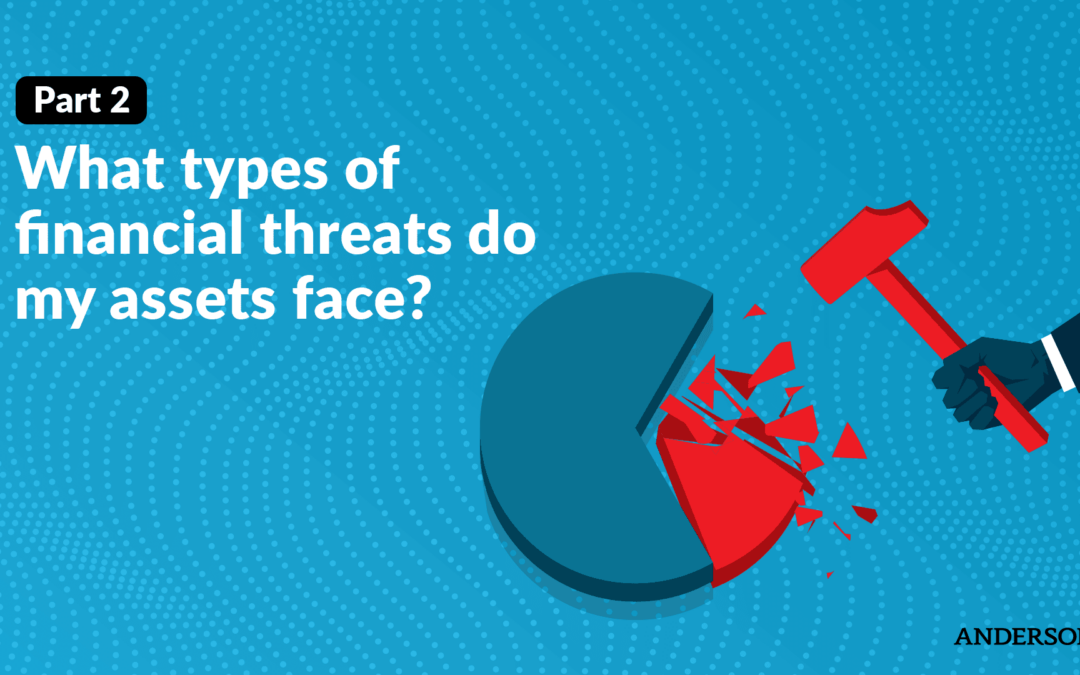
In part one of this article, we learned what assets and financial risks are and how they can affect individuals, investors, businesses, and corporations. In part two, we’ll discuss ways to protect your assets, the various protection trusts we can set up, and other methods to shield your assets from financial risks.
Key Takeaways
- Asset protection shields your valuables from potential creditor claims.
- Creating a business entity is the first step in an asset protection plan.
- Consider setting up a trust to shield your assets before a creditor claim.
- Consult with your financial advisor for information on the best type of asset-protection trust for your needs.
- Having insurance is not enough to fully cover your assets from financial threats.
What Is Asset Protection?
Asset protection is a set of strategies created to shield the assets (tangible and intangible items that have economic value) you possess as an individual, business owner, or investor from creditor claims. What can cause a creditor to try to seize your assets? There are several reasons, including:
- Payment default
- Partner disputes
- Vehicle accident
- Personal injury
- Dog bites
- Breach of contract
- Insurance lapse
- Loan default
- Product liability
If your assets aren’t protected, creditors can try to seize them to pay your debts. Having asset protection can bar creditors from accessing your assets without breaching the debtor-creditor law.
Tax & Asset Protection Workshop
Learn about Real Estate & Asset Protection at our next
FREE LIVE STREAM
How Does an Asset Protection Plan Protect Against Financial Risks?
When your financial advisor sets up an asset protection trust, the assets become part of the trust, and your name as an individual, business owner, or real estate investor is shielded. A court cannot seize protected assets when the trust is set up properly. If assets are not in your name or your business’s name, a creditor’s lawyers won’t be able to see them and, therefore, can’t seize them. Setting up asset protection properly helps protect your financial privacy.
Having an asset protection plan in place can also help you avoid attorney and court costs. If you don’t shield your assets and are taken to court by a creditor, even if the judge rules in your favor, you’ll still have to pay for the expensive legal fees.
However, not all states have comprehensive asset protection, and you’ll need to work with your financial advisor to determine whether your state has strong or weak asset protection laws. If the laws in the state where you reside don’t shield your assets as well as you’d like, your financial advisor can set up a trust in a state with strong asset protection laws or even create an offshore trust.
Because of the complexity of creating a trust, including estate planning and tax planning, it’s wise to work closely with your financial advisor, especially if you have high-value assets such as real estate.
When Should an Asset Protection Plan Be Implemented?
Some individuals, businesses, and investors may wait until they have a lawsuit filed against them to initiate asset protection. However, it’s a good idea to implement protection as soon as you acquire the asset.
Having your financial advisor create your asset protection strategy before a creditor makes a claim can help prevent a fraudulent ruling and safeguard your assets. If you are hit with a lawsuit before you have implemented an asset-protection plan, act quickly to get a trust set up as soon as possible to protect your wealth.
Should I Create a Business Entity to Protect My Professional Assets?
Yes, you absolutely need to have a business entity to protect your work-related assets. If your business entity is listed as a sole proprietor, creditors can easily find and seize any assets listed under your name. A limited partnership (LP), limited liability corporation (LLC), corporation, and S corporation all have different legal requirements, tax structures, and asset-protection requirements, and you should learn the implications and nuances of each one.
Another key element to consider in business entities is the management of the structure. A registered agent such as Anderson Advisors can help you create the articles of incorporation and establish the directors, members, and shareholders, as well as keep your business in compliance with state regulations. Using a professional registered agent removes your name from the business structure, adding another level of protection from financial threats.
Seek advice from your financial advisor as to which business entity is best suited for your unique needs, whether you are a solopreneur, run a small business, have real estate investments, or own a major corporation.

Which Types of Asset Protection Are Available?
Asset-protection plans can be simple or complex, depending on your needs and the level of protection you want. Keep in mind that some trusts cost more than others to form and manage, so it’s important to strategize with your financial advisor to see which one fits your budget and needs. Asset protection plans include:
Living Trusts
People often draw up a simple will to ensure their assets are passed on to their designated beneficiaries. However, once you pass or become incapacitated, your estate goes to probate court before the assets are distributed. The probate court and legal fees can get costly.
To avoid these unnecessary fees, consider having your attorney draw up a living trust. With revocable living trusts, as the grantor, you can change the terms of the trust while you’re alive. Upon your death, the trustee distributes the assets to the beneficiary or beneficiaries. An irrevocable trust cannot be changed and allows for deeper asset protection and tax implications. Speak with your financial advisor as to which type of trust you’ll need.
Domestic Asset-Protection Trust (DAPT)
If you decide to create an irrevocable trust, and your state allows for it, consider having your attorney draft a domestic asset-protection trust (DAPT). This unique form of asset protection, also known as a self-settled spendthrift trust, allows you, the grantor, to also become a beneficiary.
However, the trustee of the DAPT is held to your time frame and requirements, whether you designate yourself as the beneficiary or someone else. An administrative trustee is the third party that makes up a DAPT. Only some of the states in the U.S. allow DAPTs, and Nevada is one of them.
Nevada Asset-Protection Trust
For over two decades, Nevada has been the leader in DAPT trusts. At Anderson Advisors, we can draw up a Nevada asset-protection trust (NAPT) that gives residents of Nevada, or those who wish to set up their asset protection trust in Nevada, top asset protection. Ease of use for the grantor of the NAPT is one of the primary reasons people use this form of trust. If you want to transfer assets into your trust, you can do so on a regular basis without having to sign a new affidavit of solvency, required for other DAPT jurisdictions.
Offshore Asset-Protection Trust
As an individual, business owner, or investor, if you have large amounts of high-value assets, such as expensive real estate, you may want to have an offshore asset-protection trust (OAPT). This type of trust does not allow local courts, such as any court within the United States, jurisdiction over the trustee.
Many offshore trusts are based in the Cook Islands or Caribbean Islands and have an excellent reputation for protecting self-settled spendthrift trusts. While an OAPT is a good way to protect your assets from financial threats, it is not meant to hide assets for unreportable taxable income. Because OAPTs are expensive to set up and maintain, you’ll want advice from your financial advisor to make sure this is the right trust for your situation.
Will Insurance Cover My Assets?
Insurance will cover some of your assets, but insurance policies are limited to how much and what they’ll cover. For real estate investors and property owners, insurance can help offset the cost of damage to the property and provide some level of security for personal property protection.
However, insurance can’t shield your assets from creditors trying to seize the property for repayment. Of course, you need insurance for your vehicle, boat, healthcare, and properties, but you also need to form a business entity and get an asset-protection strategy in place to protect your hard-earned wealth.
Free Strategy Session with an Anderson Advisor
Receive a detailed risk assessment to assist in lowering problem areas that could wipe out all of your assets with one wrong move. Speak with an Anderson Professional Advisor to get your FREE Strategy Session. Limited-Time Offer: FREE (a $750 value.)
What Other Strategies Can I Use to Protect My Assets?
Creating a business entity, getting insurance, and working with a professional financial advisor are the first steps to protect your assets from financial threats. Keep your personal and business finances separate, transfer all properties and assets into your business entity, and avoid having large amounts of cash to help reduce the risk of lawsuits. You can open a bank account within the business entity to help protect personal assets.
Work With a Professional Advisor
Understanding the importance of having asset protection is the first step towards reducing or negating financial risks to your assets, whether small or large, tangible or intangible. Our professional team at Anderson Advisors will work with you to create the perfect asset-protection strategy based on your unique needs. Call us today at 800-706-4741 to schedule an appointment to learn more about asset protection, estate planning, and tax planning. You can also learn more about our Platinum Membership, which gives you unlimited access to our attorneys and tax professionals without paying hourly rates.













